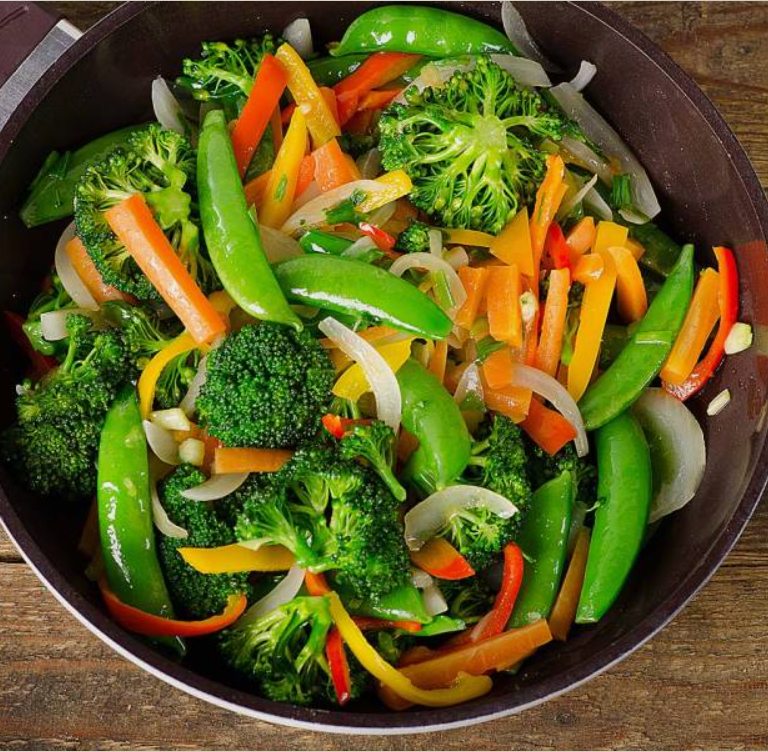Introduction: In the realm of quick and nutritious meals, veggie stir-fry reigns supreme. This versatile dish not only tantalizes taste buds but also packs a punch of essential nutrients. Our veggie stir-fry with soy sauce and garlic recipe offers a harmonious blend of flavors, accentuated by the savory richness of soy sauce and the aromatic allure of garlic. Whether you’re a seasoned chef or a kitchen novice, this recipe promises a culinary adventure that’s both simple and satisfying.

Ingredients:
- Assorted Vegetables: (Choose a colorful array such as bell peppers, broccoli, carrots, snap peas, mushrooms, and baby corn for visual appeal and nutritional variety.)
- Soy Sauce: 3-4 tablespoons (Opt for low-sodium soy sauce if watching your salt intake.)
- Garlic: 3-4 cloves (Finely minced or crushed for optimal flavor infusion.)
- Vegetable Oil: 2 tablespoons (Use a high-heat oil like sesame or peanut oil for stir-frying.)
- Optional Additions: (Customize your stir-fry with protein sources like tofu, tempeh, or seitan. You can also sprinkle sesame seeds or chopped green onions for garnish.)
Instructions:
- Preparation:
- Wash and chop your assorted vegetables into bite-sized pieces. Keep them uniform in size for even cooking.
- Mince or crush the garlic cloves finely. Set aside.
- If including tofu or any protein source, ensure they’re drained and cut into cubes or slices.
- Heat the Wok or Skillet:
- Place a wok or a large skillet over medium-high heat.
- Add vegetable oil and swirl to coat the bottom evenly. Let it heat for a minute until shimmering but not smoking.
- Sauté Garlic:
- Once the oil is hot, add the minced garlic to the wok.
- Stir continuously to prevent burning and cook until fragrant, approximately 30 seconds to 1 minute.
- Add Vegetables:
- Carefully add the chopped vegetables to the wok.
- Stir-fry them quickly, allowing each piece to sear while retaining its crispness.
- Cook for about 3-5 minutes or until the vegetables are tender yet still vibrant in color.
- Incorporate Soy Sauce:
- Drizzle the soy sauce evenly over the vegetables.
- Continue to stir-fry for an additional 1-2 minutes to allow the flavors to meld together.
- Adjust the amount of soy sauce according to your taste preferences.
- Optional Protein Addition:
- If you’re including tofu or any protein source, gently fold it into the vegetable mixture.
- Allow it to heat through for 2-3 minutes, ensuring it absorbs the flavors of the stir-fry.
- Serve Hot:
- Once everything is cooked to perfection, remove the wok from the heat.
- Transfer the veggie stir-fry to a serving dish.
- Garnish with sesame seeds or chopped green onions if desired.
- Serve hot alongside steamed rice or noodles for a complete and satisfying meal.
Serving Tips:
- Pair with Rice or Noodles: Serve your veggie stir-fry with a side of fluffy steamed rice or tender noodles. The combination of savory stir-fry and fluffy grains creates a satisfying and balanced meal.
- Garnish for Flavor: Sprinkle some sesame seeds or chopped green onions over the stir-fry just before serving. These garnishes not only add a pop of color but also contribute a delightful flavor and texture contrast.
- Add a Splash of Heat: For those who enjoy a bit of spice, consider drizzling some chili oil or sprinkling red pepper flakes over the finished dish. This adds a fiery kick that elevates the flavor profile of the stir-fry.
- Serve with Fresh Herbs: Accompany your veggie stir-fry with a side of fresh herbs such as cilantro, Thai basil, or mint. These aromatic herbs complement the savory flavors of the dish and add a refreshing touch to each bite.
- Create a DIY Stir-Fry Bar: Make mealtime interactive by setting up a DIY stir-fry bar with various toppings and sauces. Let everyone customize their stir-fry with their favorite ingredients, from crunchy peanuts to tangy citrus zest, for a fun and personalized dining experience.
Storage Tips:
- Refrigerate Promptly: After allowing the stir-fry to cool to room temperature, transfer it to an airtight container and refrigerate promptly. Proper storage helps maintain freshness and prevents bacterial growth.
- Use Within 3-4 Days: Consume the leftover veggie stir-fry within 3-4 days for optimal flavor and texture. Beyond this timeframe, the vegetables may start to lose their crispness and the flavors may diminish.
- Separate Containers for Protein: If your stir-fry includes tofu or another protein source, consider storing it separately from the vegetables to prevent them from becoming soggy. This allows you to reheat each component individually as needed.
- Reheat with Care: When reheating the stir-fry, use a non-stick skillet or microwave-safe dish. Add a splash of water or vegetable broth to prevent the vegetables from drying out, and heat gently until warmed through.
- Revive with Fresh Additions: If the leftover stir-fry seems a bit lackluster, freshen it up with additional vegetables or a splash of soy sauce before reheating. This helps restore its vibrancy and ensures a delightful dining experience with each bite.
Variations:
- Teriyaki Twist: Swap out the soy sauce for teriyaki sauce to add a sweet and tangy flavor profile to your stir-fry. Teriyaki sauce pairs wonderfully with vegetables and creates a deliciously caramelized glaze when cooked.
- Spicy Szechuan Style: Give your stir-fry a kick by incorporating Szechuan peppercorns and chili paste. Szechuan cuisine is known for its bold, spicy flavors, and this variation will tantalize your taste buds with its fiery heat and numbing sensation.
- Coconut Curry Creation: Transform your stir-fry into a creamy coconut curry by adding coconut milk, curry paste, and a squeeze of lime juice. This variation brings a tropical twist to the dish and offers a rich and aromatic curry sauce that coats the vegetables beautifully.
- Ginger Infusion: Infuse your stir-fry with the zesty warmth of fresh ginger by adding thinly sliced or grated ginger along with the garlic. Ginger adds a refreshing kick and pairs exceptionally well with Asian-inspired flavors, enhancing the overall depth of the dish.
- Citrus Sensation: Brighten up your stir-fry with a burst of citrus flavor by adding orange or lemon zest and a splash of citrus juice. The tangy acidity of citrus fruits adds a refreshing contrast to the savory notes of the soy sauce and garlic, creating a vibrant and lively dish.
- Mediterranean Medley: Put a Mediterranean spin on your stir-fry by incorporating Mediterranean vegetables such as zucchini, eggplant, and cherry tomatoes. Season with a blend of herbs like oregano, thyme, and basil, and finish with a drizzle of balsamic glaze for a touch of sweetness.
- Crispy Cashew Crunch: Add crunch and nuttiness to your stir-fry by tossing in roasted cashews or peanuts during the final stages of cooking. The toasted nuts lend a satisfying texture and depth of flavor to the dish, making each bite a delightful sensory experience.
- Green Goddess with Pesto: Elevate your stir-fry with the vibrant flavors of homemade pesto. Stir in a dollop of basil pesto just before serving to infuse the dish with the herbaceous aroma of fresh basil, pine nuts, and Parmesan cheese.
- Mexican Fiesta: Give your stir-fry a Mexican flair by seasoning it with taco seasoning or a blend of cumin, chili powder, and smoked paprika. Add black beans, corn, and diced tomatoes for a hearty and flavorful variation that’s perfect for taco night.
- Soy-Free Substitute: For those with soy allergies or sensitivities, replace soy sauce with coconut aminos, a gluten-free and soy-free alternative made from coconut sap. Coconut aminos offer a similar umami flavor profile without the allergens, making it suitable for a wider range of dietary preferences.
FAQs:
- Can I use frozen vegetables for this stir-fry recipe?
- Yes, you can use frozen vegetables if fresh ones are not available. However, keep in mind that frozen vegetables may release more moisture during cooking, so adjust the cooking time accordingly to prevent them from becoming soggy.
- Is it possible to make this stir-fry gluten-free?
- Absolutely! Simply substitute soy sauce with tamari, which is a gluten-free alternative made from fermented soybeans. Alternatively, you can use coconut aminos for a soy-free and gluten-free option.
- Can I make this recipe ahead of time for meal prep?
- Yes, this stir-fry is perfect for meal prep. You can prepare the vegetables and sauce ahead of time, storing them separately in the refrigerator. When ready to eat, simply stir-fry everything together until heated through.
- What protein options work well with this stir-fry?
- Tofu, tempeh, seitan, chicken, shrimp, beef, or pork are all excellent protein options for this stir-fry. You can customize it based on your dietary preferences and availability of ingredients.
- How can I make this stir-fry spicier?
- To add more heat to your stir-fry, increase the amount of chili paste, red pepper flakes, or fresh chili peppers. You can also stir in some Sriracha or hot sauce according to your spice tolerance.
- Can I freeze leftover stir-fry for later use?
- While it’s possible to freeze leftover stir-fry, the texture of the vegetables may become softer upon thawing and reheating. It’s best to consume the stir-fry fresh or refrigerate it for up to 3-4 days for optimal quality.
- How do I prevent my stir-fry from becoming soggy?
- To avoid soggy stir-fry, make sure to stir-fry the vegetables over high heat in a well-heated wok or skillet. Cook them quickly to retain their crispness, and avoid overcrowding the pan, which can lead to steaming instead of stir-frying.
- Can I customize the vegetables used in this stir-fry?
- Absolutely! Feel free to mix and match your favorite vegetables based on personal preference or what’s in season. Just keep in mind the varying cooking times of different vegetables and adjust accordingly.
- Is this stir-fry suitable for a vegan or vegetarian diet?
- Yes, this stir-fry is naturally vegan and vegetarian-friendly. It’s packed with nutritious vegetables and can be customized with plant-based protein sources like tofu or tempeh for a complete meal.
- How do I adjust the seasoning to suit my taste preferences?
- Feel free to adjust the amount of soy sauce, garlic, and other seasonings according to your taste preferences. Start with smaller amounts and taste as you go, adding more if needed until you achieve the desired flavor profile.
Conclusion:
In conclusion, our veggie stir-fry with soy sauce and garlic recipe offers a versatile and flavorful dining experience that’s perfect for any occasion. Whether you’re craving a quick weeknight meal or planning a leisurely weekend feast, this stir-fry delivers on both taste and nutrition. With customizable variations, serving tips, storage advice, and FAQs to address common queries, you have all the tools to create a delicious stir-fry tailored to your preferences and dietary needs.
Embrace the culinary adventure of stir-frying with vibrant vegetables, savory soy sauce, and aromatic garlic, and let your creativity shine with optional additions and variations. From teriyaki twists to coconut curry creations, there’s a world of flavors to explore within this simple yet satisfying dish.
So gather your ingredients, fire up the wok, and embark on a journey of culinary delight with our veggie stir-fry recipe. With each flavorful bite, savor the magic of homemade Asian-inspired cuisine right in your own kitchen. Whether enjoyed solo, shared with loved ones, or meal prepped for busy days ahead, this stir-fry is sure to leave you craving more.
